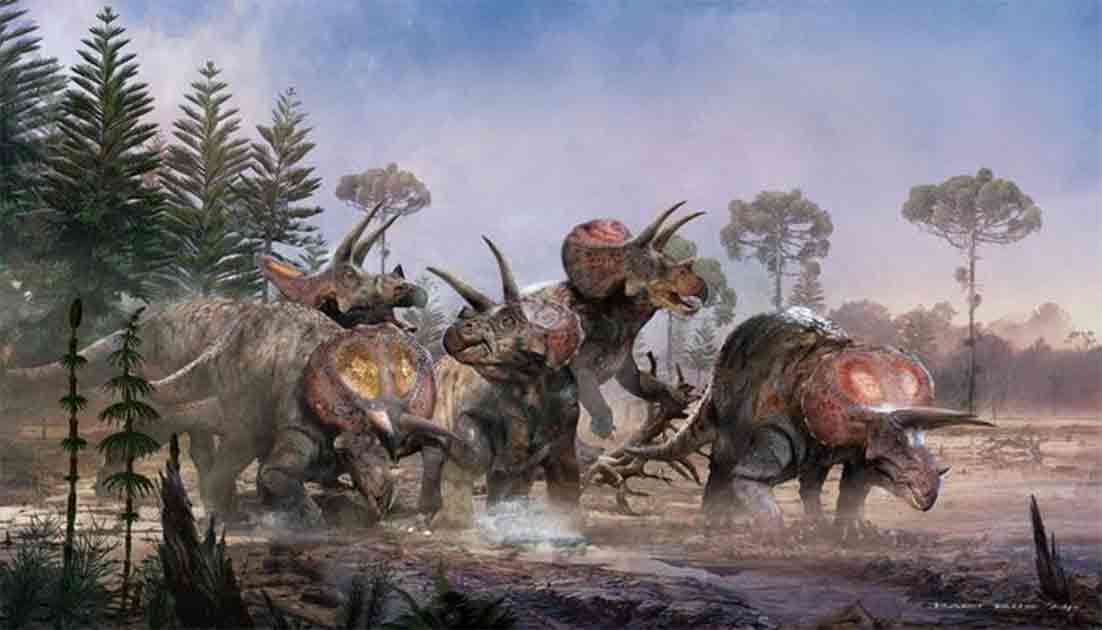New Element of Triceratops Defense Found In Wyoming Fossils
Though Spielberg’s Jurassic Park got a few things wrong historically, it seemed to have got some things spot on. Triceratops, the dinosaur with three horns and the large neck frill, may have indeed lived and moved in herds, in line with the cinematic depiction. This discovery comes as 11 years of digging at a quarry in Wyoming, USA are wrapping up, revealing a treasure trove of 1,200 bones and bone fragments belonging to at least five Triceratops horridus specimens.
From T-Rex to Triceratops: Unveiling the Evidence
Initially on the hunt for Tyrannosaurus rex remains in 2013, palaeontologists stumbled upon the largest collection of Triceratops fossils ever unearthed. Prior to this discovery, the fossil record provided no indication that these ancient three-horned dinosaurs exhibited anything other than solitary behavior. However, recent research conducted at the Naturalis Biodiversity Center in the Netherlands has unveiled evidence suggesting that at least some of these creatures lived in social groups, reports Naturalis Biodiversity Center.
“And that of course leads to all kinds of new questions,” says PhD candidate and lead researcher Jimmy de Rooij from Utrecht University in the Netherlands. “How complex was this social behavior, exactly?”
- Killer Dueling Dinosaurs Fuel Major Museum Project
- New Duckbill Dinosaur Evidence Shows That Dinosaurs Crossed Oceans
Triceratops, often portrayed as the fierce adversary of T. rex, coexisted during the twilight of the Cretaceous period (145–66 million years ago), meeting their end with the catastrophic asteroid event that sealed the fate of the dinosaurs. These ancient herbivores, it is believed, served as prey for the mighty Tyrannosaurus rex.
Among the myriad skeletal remnants lay hundreds of teeth. Chemical analysis of these fossils suggests a migratory lifestyle, with all five individuals following the same route, indicating herd behavior.
- Before the Era of Dinosaurs, There Was a Ten-Legged Octopus
- Tyrannosaurus Rex Likely Hunted in Packs - and There Were Billions of Them!
Renowned for their formidable three-horned visages and distinctive frilled necks, Triceratops boasted skulls among the longest of any terrestrial creature, extinct or extant, measuring roughly 2.5 meters (8.2 feet) from frill tip to beak. Each eye was adorned with horns stretching about a meter in length, complemented by a smaller nasal horn.
In terms of size, Triceratops were colossal. Reaching lengths of up to 9 meters (29.5 feet) and weighing between 6 to 12 tons, they rivaled or even surpassed the heft of large bull African elephants, reports Cosmos Magazine.
“This enabled us to show that these Triceratops grew really slowly, for instance,” de Rooij adds.

Big John, found in South Dakota, at 8 (26ft) meters long is the largest triceratops skeleton ever found. (Eviatar Bach/CC BY-SA 4.0)
Triceratops were herbivores, predominantly consuming low-lying vegetation like ferns, cycads, and other plants that thrived during the Late Cretaceous period. Their fossils have been predominantly discovered in North America, particularly in the western United States, with notable findings in states such as Montana, South Dakota, and Wyoming. Like numerous other dinosaurs, Triceratops met their demise approximately 66 million years ago during the Cretaceous-Paleogene extinction event.
De Rooij’s supervisor, Prof. Anne Schulp (Naturalis/Utrecht University), is very happy about the entire trajectory from dig to defense ceremony.
“Naturalis, the national natural history museum of the Netherlands, now has the biggest triceratops find in the world, and Utrecht University has the first Dr Triceratops in the Netherlands. De Rooij’s work didn’t just result in research papers, but also in an exhibition about his findings. As of October, the exhibition will kick off at Naturalis - and kick off the world tour - where the five triceratops are shown as they lived and died 67 million years ago: together.”
Top image: A heard of Triceratops horridus walking through a Cretaceous swamp. Source: Bart Bus/Naturalis Biodiversity Center
By Sahir Pandey
References
Bolevich, M. 2024. Spielberg’s vision true: Dinosaurs lived, died together 67M years ago. Available at: https://interestingengineering.com/science/spielbergs-vision-true-dinosaurs-lived-died-together-67m-years-ago.
Carvajal, G. 2024. Spielberg Was Right: Study Shows Five Triceratops Lived and Died Together. Available at: https://www.labrujulaverde.com/en/2024/03/spielberg-was-right-study-shows-five-triceratops-lived-and-died-together/.
Thomson, J. 2024. 'Jurassic Park' Vindicated As Triceratops Shown To Have Lived in Herds. Available at: https://www.newsweek.com/triceratops-fossils-found-wyoming-herd-paleontology-1883523.
Yazgin, E. 2024. Biggest find of Triceratops fossils proves they were social dinosaurs. Available at: https://cosmosmagazine.com/history/palaeontology/triceratops-fossils-herd/.


















Comments
Did an asteroid seal the fate of these mighty behemoths?
No, ah, a flood of evidence is rising, that it was an event of Biblical proportions after all...